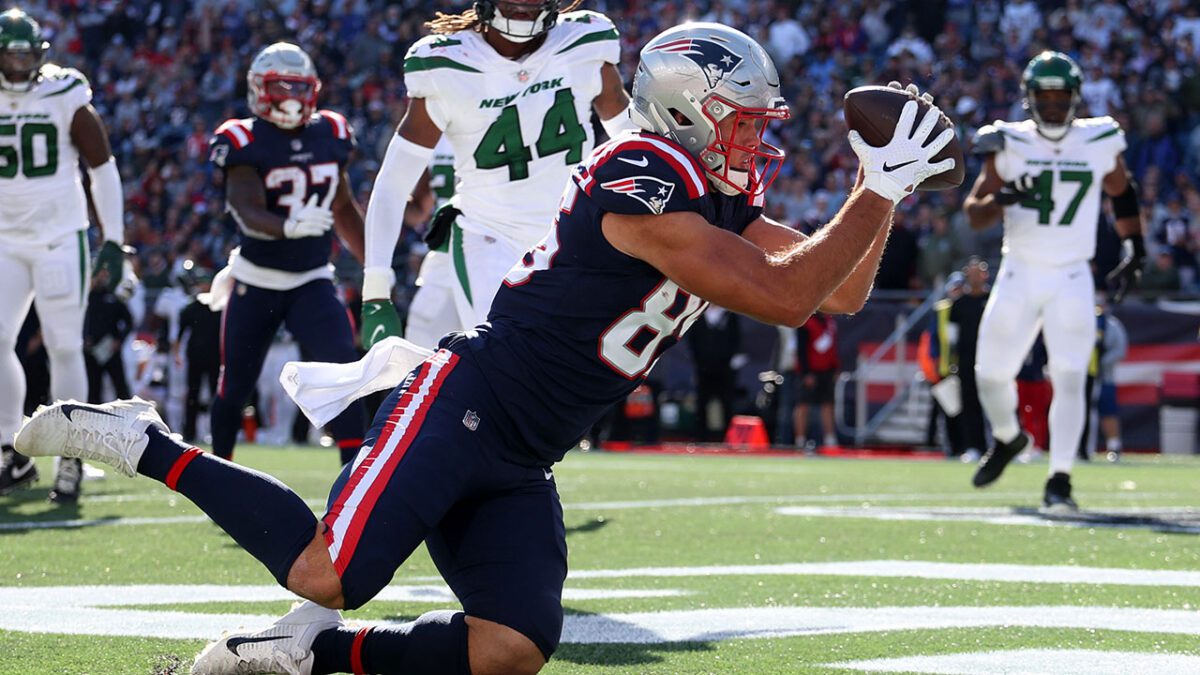Be Wary of the Steelers Wide Receivers
Last season, the Pittsburgh Steelers threw the ball 656 times. 26 more times than the Patrick Mahomes-led Kansas City Chiefs. All three Steeler wide receivers finished in the top-24 for overall wide receiver scoring (full-PPR). By all accounts, this looks like a passing game fantasy managers should be heavily investing in, right? I’m here to tell you to slow down. There are some red flags going up in Pittsburgh fantasy managers need to be cognizant of, especially as it relates to their passing game.
Despite having three receivers all vying for targets, one would think the price would be deflated. After all, more competition often means less work. We see this with the Bengals where their third-ranked receiver is Tyler Boyd at WR34. The Buccaneers’ third-ranked receiver is Antonio Brown WR44 and the Cowboys’ third guy is Michael Gallup at WR46. The Steelers? Their third-ranked receiver is Chase Claypool at WR31. JuJu Smith-Schuster is at WR27 and Diontae Johnson is at WR20. Some of this is impacted by the fact that the Cowboys and Buccaneers have two established players leading the way, while the Bengals and Steelers’ hierarchy is somewhat more up for grabs.
Embed from Getty ImagesWhen we look at their ADPs, we found they are slightly flip-flopped, however. Johnson is holding steady at WR20, while Claypool jumps up to WR28 and JuJu falls to WR31. The lowest ADP of the other No. 3 receivers are WRR38 (Tyler Boyd), WR46 (Antonio Brown), and WR47 (Michael Gallup). However, since the 2020 season ended, the Steelers have gone through several huge offensive changes. What does that mean for the Steeler receivers in 2021?
A Supply and Demand Tug-of-War
When the Steelers drafted Najee Harris in the first round of the 2021 NFL Draft, a warning light should’ve been going off for every fantasy manager looking to buy into the Steelers’ passing game. We know how much running backs have been devalued across the league the past few years. We’ve seen it in the kinds of contracts they’re getting and how many are being drafted in the first round. So when a team selects a running back in the first round, what does that mean?
That kind of investment is not made without a concrete plan of how to maximize its return. Selecting a first-round running back isn’t just a statement, it’s the first step in altering the offensive philosophy. Last year, that philosophy was built around Ben Roethlisberger and the passing game. While selecting Harris may not mean a directly opposite approach of being a run-first offense, it does, without question, meaning they intend to and are committed to being a more balanced one. Any decrease in pass attempts is a bad one for the Steelers’ trio. There’s simply not enough separation between the three of them where they aren’t all negatively affected by it.
In other situations across the league, pass attempts may drop in Green Bay or Arizona, or Kansas City, but the alpha receivers in those offenses won’t see their volume decrease. It will be the role players who will take the hit. The problem in Pittsburgh is that kind of alpha-player does not exist. For those of you clamoring about Diontae Johnson being that alpha-receiver, I got news for you. Alpha receivers do not fail to rack up 925 yards when receiving 144 targets. In fact, that very well might be the definition of how you can tell who is not an alpha player. Fantasy managers also need to remember the Steelers’ had a rookie who put up 873 yards on just 109 targets.
Remember when JuJu had 111 catches and 1,426 yards in 2018 and then in 2019 he was effectively replaced by Diontae? The point being, JuJu struggled as the alpha in 2019 and was replaced by Diontae. Diontae struggled as the alpha in 2020 and they have Chase Claypool in waiting who had a very impressive rookie season. What will 2021 hold? I don’t expect there will be an alpha in Pittsburgh. It’s only reasonable to expect Claypool to take a step forward in his sophomore season, which will only cluster these three receivers closer together. Creating an even more maddening situation for fantasy managers.

Chase Claypool is going to do to Diontae Johnson in 2021 what Diontae Johnson did to JuJu Smith-Schuster in 2020.
— Rob (@RobFFAddict) July 16, 2021
Last season, the Steelers averaged 41 passes per game and only 23 rushes. Fantasy managers shouldn’t expect anything close to that in 2021. Not if Najee Harris does what everyone expects him to do. He’s going to give the Steelers’ run game a shot in the arm. There’s a good reason the Steelers’ offense will want to get the run game clicking too. It’s not like the Steelers’ passing attack was all that success in and of itself.
Big Ben averaged just 6.6 adjusted yards per attempt. This was a lower average than guys like Mitchell Trubisky, Jared Goff, Gardner Minshew, and Teddy Bridgewater. His actual yards per attempt was even worse at 6.3. This was fifth-worst in the league. Big Ben and the receivers were as “successful” as they were last season and I put successful in quotations because on an efficiency level, they weren’t successful at all. But as it pertains to fantasy football, volume can cure almost anything and that’s how Big Ben, Diontae, and JuJu got it done last year for fantasy managers. It was entirely off the back of volume. What happens when that volume isn’t there?
I anticipate Najee Harris getting about 18 carries per game with the secondary running backs chipping in another 10 carries between themselves on a weekly basis. That’s immediately a decrease of five pass attempts per week. Other the course of an entire season that equals 80 fewer pass attempts, which is not a small number by any means. The other thing fantasy managers need to recognize and it’s largely forgotten, but any increase in rushing attempts per game is going to shorten the game. The clock keeps ticking and likely generates fewer plays overall. This could also decrease how many pass attempts Big Ben has on a weekly basis.
In the last 3 seasons there has only been one time (2020 Steelers) where a top 5 defense also had an offense top 5 in pass attempts. These two typically have a negative correlation. Add in Najee Harris & you can expect the Steelers to pass the ball a lot less in 2021.
— Rob (@RobFFAddict) July 13, 2021Love our content? Check out the GoingFor2 Live Podcast Network!
Another important aspect to take notice of is the Steelers’ defense. This was a top-3 unit in yards allowed and points allowed last season. In the last five seasons, there have only been two occasions where a top-5 defense in yards allowed also had an offense in the top-5 in pass attempts. These two aspects generally carry a negative correlation between the two of them. The better your defense is, the less likely you are to pass the football. All of this goes back to the original point in that fantasy managers should expect a possibly significant decrease in the total of pass attempts in Pittsburgh in 2021.
We’ve already touched on the tug of war as it relates to passing attempts vs rushes, but what about touchdowns? Last season, the Steelers had 35 passing touchdowns to only 12 rushing touchdowns. They were tied for the third-lowest amount of rushing touchdowns in the NFL last season and the fifth-most passing touchdowns. Najee Harris is going to change that narrative a bit. It may not be drastic, but the Steelers are going to score more rushing touchdowns in 2021. The rookie out of Alabama is that talented. And any increase in rushing touchdowns is likely to have a negative correlation with the number of passing touchdowns, so fantasy managers should expect there to be less than 35 passing scores to go around.
Unknown Roles
The new offensive coordinator is Matt Canada. Fantasy managers know nothing about this guy. His first stint in the NFL game was last season as the quarterback coach for the Steelers. Prior to that, he has multiple different stops in the college ranks. He’s bounced around quite a bit recently too.
He was the offensive coordinator for Northern Illinois in 2011 before moving on to the same role for Wisconsin in 2012. From 2013-2015 he was the offensive coordinator for NC State. He followed that job up with offensive coordinator stints at Pittsburgh (2016), LSU (2017), and Maryland (2018). Due to the yearly changes where he’s constantly working with different personnel, it’s hard to know what a true Matt Canada offense looks like. It’s a complete unknown. The only thing we know is the Steelers want to run the ball more. That much we know because they told us so when they drafted Najee Harris.
How does he want to use his receivers? Unknown. What the hierarchy will be? Unknown. Fantasy managers cannot pretend that Diontae Johnson was heads and shoulders above JuJu and Claypool because the statistics simply do not say that was true. The only number that can be pointed to in that regard is the number of targets Diontae received. But don’t you think the new coach is going to care a whole heck of a lot more about what the players did with their targets rather than we got them the previous season?
Pittsburgh Steelers wide receiver targets/game the last two seasons
— Adam Koffler (@AdamKoffler) July 15, 2021
𝟮𝟬𝟭𝟵:
JuJu Smith-Schuster – 5.8
Diontae Johnson – 5.8
James Washington – 5.3
Total = 16.9
𝟮𝟬𝟮𝟬:
Diontae Johnson – 9.6
JuJu Smith-Schuster – 8
Chase Claypool – 6.8
Total = 24.4 👀
Something’s gotta give
The new offensive coordinator gives fantasy managers another wrinkle they need to somehow unravel when trying to accurately put a value on each of these three receivers. The fact that we know their pass attempts are going to decrease, the question is by how much, only adds to the intrigue of how Matt Canada will choose to use his trio of receivers. A lot of this may yet be undecided too.
Claypool is entering his second season after a very promising rookie season, so improvement can be expected. JuJu took a one-year deal this off-season to hopefully parlay that into a big contract in 2022, so fantasy managers should expect him to be locked in. What does that mean for the target distribution in what is likely going to be a fairly new offense? It’s unknown and that’s the worrisome point.
A Lack of Efficiency
As fantasy football players, we’re all likely to have heard “volume is king” or “follow the volume” in some sort of fashion. It’s entirely true. Players cannot score fantasy points without being given the ball. It is the No. 1 prerequisite to fantasy football scoring, you simply need the football. This is the best part of Diontae Johnson’s game right now, volume. He had 144 targets last season. The problem is he only scored 1.54 points per target. This was the second-lowest average a top-30 wide receiver has had in the past three years. During that time frame, wide receivers who finished 11-20 have averaged 1.89 yards per target. So the question becomes how much can fantasy managers depend on Diontae receiving an elite target share? Especially when JuJu came in at 1.83 points per target and Claypool rocked out at 1.97. There’s really no way around it, JuJu and Claypool were both more efficient pass-catchers last season.
The problem for Smith-Schuster is a disgusting 8.6 yard per reception average, which was 104th among receivers according to playerprofiler.com. Diontae Johnson was better, just not in any significant way. He averaged 10.5 yards per reception, which was 88th among receivers. Neither player finished in the top-45 in yards per route run, a telling metric for wide receivers. Some may argue part of the problem was a quarterback who had lost his mojo, but as far as 2021 is concerned, that doesn’t do anyone any favors because Big Ben is set to be under center again for the Steelers.
Claypool on the other hand was much more efficient despite everything around him. He averaged 13.9 yards per reception (33rd) and 1.99 yards per route ran (26th). The former Fighting Irishmen was the most dynamic receiver for the Steelers and he also comes with the most imposing and physical gifts among any of the three. It would be hard for a new offensive coordinator not to want to feature Claypool more in the passing game. And as it relates to Johnson and Smith-Schuster, this is part of the problem. They’re both ranked ahead of Claypool, but Claypool was a rookie and was still significantly more efficient than the two of them on the looks he received. Now, there’s a new offensive coordinator who may look at what Johnson and Smith-Schuster did and ask himself, why not Claypool? Fantasy managers need to be asking themselves the same question. Remember, the switch happened just two years ago from JuJu to Diontae after Smith-Schuster was crowned the next big Steeler receiver.
If we’re talking about the lack of efficiency, there’s just no way we can talk about the Steelers’ passing game without touching on Johnson’s problem catching the football. Drops unlike interceptions and fumbles, do not come with any negative fantasy scoring so as long as the targets keep coming, they don’t really matter all that much other than the points they could have had. However, when a player racks up 11 drops, the most in the NFL, and a new offensive coordinator takes over with a rookie who played like Chase Claypool, how sure are we that those targets are going to keep coming? Let me be clear, any decrease in Johnson’s targets is highly unlikely to be directly due to his drops, but could it play a factor? Absolutely. If you can be benched for drops (which happened to Johnson), a quarterback can start looking elsewhere with the football. Or an offensive coordinator may decide to feature someone else.
Most drops in 2020
— PFF Fantasy Football (@PFF_Fantasy) March 27, 2021
🔸 Diontae Johnson – 14
🔸 Jerry Jeudy – 12
🔸 D.K. Metcalf – 10 pic.twitter.com/GIJORXxGQS
The other aspect of the passing game that needs to be evaluated is their red-zone usage. Last season, Smith-Schuster was Big Ben’s favorite red-zone target. He received 17 targets inside the 20-yard line. Claypool received 13 targets and Diontae Johnson had 10. At first glance, those look pretty equal but remember the overall target distribution for each player. Johnson had 144 overall targets (6.9% were red zone targets), Smith-Schuster had 128 total targets (13.2% red zone targets), and Claypool had 109 targets (11.9% in the red zone). It should also be noted that Eric Ebron had 16 red-zone targets himself at the tight end position. All of this points to Diontae simply not being a weapon they used in the red zone and it makes sense. Johnson is the smallest of the three receivers and it isn’t really all that close.
Putting this into Action
Stats are cool and all, but as fantasy managers, we should be looking for data and information that impacts our choices, actionable information. Diontae Johnson is my biggest concern in the Steelers’ passing game and if you’ve gotten this far, that shouldn’t be entirely surprising. The reason the focus is on him is that he’s the most expensive receiver on the team. He’s currently being drafted ahead of DJ Moore, Cooper Kupp, and Tyler Lockett. I know, without a doubt, I would rather have all three instead of Johnson. We’ve seen all of those receivers put up good, bordering on elite fantasy numbers in the past.
Prior to last year, Kupp finished as WR4 in 2019 and WR15 in terms of PPG in 2018 (he missed eight games). He has Matthew Stafford now, a significant upgrade to Jared Goff. Tyler Lockett gets disrespected quite a bit, but this guy has finished in the top-16 the last three years. He was WR16 in 2018, WR13 in 2019, and WR8 in 2020. Kupp and Lockett have shown their elite ceilings already and both of their situations have improved this offseason. Moore’s situation also improved.
For Kupp, as mentioned already, he received a big-time quarterback upgrade. For Lockett, David Moore, Greg Olsen, and Jacob Hollister all left in free agency. They were replaced by Gerald Everett and a third-round rookie receiver. The Seahawks’ passing game is going to be very consolidated between Metcalf and Lockett. DJ Moore has over 1,175 yards receiving in back-to-back seasons with really bad quarterback play. Sam Darnold represents a talent improvement over Teddy Bridgewater and Kyle Allen. With Curtis Samuel’s exit in free agency, there are more targets to go around. Yes, Christian McCaffrey comes back, but Mike Davis and CMC received 89 total targets combined last year. It’s not like CMC is going to have that much more than that. 20? Maybe, but Samuel left behind 97. Sometimes fantasy football doesn’t need to be hard. Johnson’s situation has undoubtedly gotten worse. Najee Harris’ selection alone did that. The new coordinator throws in another question mark. Big Ben’s durability is another.
Claypool is currently being drafted at WR28 and Smith-Schuster is at WR31. Neither spot seems particularly egregious, but two receivers behind Claypool I would rather have are Tee Higgins and Courtland Sutton. Higgins is a simple one. I trust the Bengals’ passing game more than I trust the Steelers and I trust Joe Burrow more than I trust Ben Roethlisberger. The Bengals’ defense is also going to be solidly below-average again this season, increasing the likelihood of the Bengals’ playing in shoot-outs and having to lean on the passing game more. With the Steelers’ wielding a top-10 defense, that is less likely for them.
As far as Sutton, it comes down to less target competition. Sutton is only competing with Fant and Jeudy. Claypool is competing with Johnson, JuJu, and Ebron. Fantasy managers tend to have short-term memories, but Sutton was WR18 in 2019 and put up 72 catches, 1,112 yards, and six touchdowns. And one way or the other, the Broncos will have the better quarterback play in 2021. Either Drew Lock will take a step forward and keep Teddy on the bench, which is great news or Lock won’t and he’ll be benched for Teddy. Bridgewater did support three top-30 receivers in Carolina last year.
While Smith-Schuster at WR31 isn’t a terrible place to be taking him, especially after he finished WR16 last season, there are several guys that I think you can make the argument for solely based on upside. Those guys are DJ Chark and Devonta Smith. JuJu didn’t even break 850 yards last season despite 97 catches. He was a PPR monster because of volume, but we’ve already touched on those concerns already. Chark is now catching passes from Trevor Lawrence and Devonta Smith is likely to walk into an immediate-alpha role in Philadelphia.
For me, the Steelers’ passing game just has way too many questions marks to feel comfortable. It’s not even all about the question marks, although that’s a big part of it, it’s the fact there are better options being drafted behind them whose situations either have improved or at the very least, aren’t nearly as murky as they are in Pittsburgh. If I am going to bet on any of them, it’s going to be Claypool. I’m going to bet on talent and Claypool is the most talented receiver on this roster. It isn’t even close.
ATTN Dynasty Commissioners: Do you want to do something cool for your league? How about a 1-hour live show dedicated to YOUR league? Team-by-team breakdowns, rankings, and more. For details and to book a show, visit: GoingFor2.com/plp.





